With over 270 million monetizable daily active users, Twitter is always filled with trending topics, breaking news, and timely discussions. While millions of tweets are shared per day, you can search them all—plus the multi-million profiles attached to them—using the amazing yet little-known Twitter Advanced Search tool.
Advanced Search is a goldmine for marketers and small business owners because you can easily find new customers and search for specific tweets. Rather than just letting Twitter’s Algorithm choose which tweets you see, advanced search allows you to find tweets that are most relevant to you.
In this post, we'll show you how, and we'll also share a whole host of other top tips and tricks to help your business win with Twitter Advanced Search.
You can now schedule Twitter Threads in Buffer. Get started today for free.
How to find Twitter’s Advanced Search
Advanced Search is available when using Twitter’s website—you can access it directly by heading to twitter.com/search-advanced. Alternatively, you can enter your query into the search bar on Twitter’s home page and then click Advanced Search located next to the search filters on the upper-right of your results page.

Unfortunately, you can not access the advanced Twitter search tool directly within Twitter’s mobile app. However, you can still access it through your phone’s web browser by visiting https://mobile.twitter.com/search-advanced.
Navigating Twitter Advanced Search
At first glance, the Advanced Search results page may appear a little overwhelming. There are quite a few fields to consider and it’s a little daunting figuring out where to start, but it's ultimately a powerful search engine you can use to your advantage. We’ve put together this quick guide to help you find your way around.

Search filters to use
With these search filters, you can choose the text that you want—or don’t want—to appear in your search results. This makes it possible to quickly find specific tweets and specific keywords on the social media platform.
Searching for specific words or phrases
- All of these words: Enter two or more words in this field, and you'll see tweets that contain those terms (in no particular order). You can search for one or more phrases by using quotations to separate each, for example, "social media" and "social marketing."
- This exact phrase: It's best to search for just one phrase in here. This field is particularly useful if you want to search for names or quotes.
- Any of these words: This field is great to search for multiple words. For example, you could use “Buffer,” “@Buffer,” and “#Buffer” to search for all things Buffer-related.
- None of these words: Whatever you put in here will exclude tweets from your search results that contain the specified words or phrases.
- These hashtags: This one helps you hone in on specific hashtags, for example, #Buffer.
- Written in: This option will allow you to find tweets in any of Twitter’s 34 supported languages.
- Replies or original tweets: You can also choose whether you want to see only original tweets or all tweets – including replies – in your search results.
Searching for people or accounts
- From these accounts: This one will only show you tweets from the specific accounts you choose. ( example: tweeted by “@Buffer”).
- To these accounts: These are tweets sent as replies to a specific account (example: in reply to “@Buffer”).
- Mentioning these accounts: Enter an account name in this field to see any tweets that mention a specific account (example: tweets that include “@Buffer”).
Searching for the location where the tweet was sent
- Near this place: You can see tweets sent while a person was in a particular area.
Searching for the date a tweet was sent
- From this date to this date: This is an incredibly easy way to search for tweets in a specific date range. For example, you could find out what Twitter users were saying during a marketing campaign or when certain topics were trending. This is a convenient way to find old tweets that may not appear on your Twitter timeline.
In addition to the Advanced Search page, there are a couple of other great resources to help you refine your results. Twitter’s search results page has menu options for filtering results by media type, profiles, and more.

And you can also do quite a number of advanced search tricks from any Twitter search bar by combining Twitter search operators.
20 Cool and Sneaky Ways to Use Twitter Advanced Search for Marketing and Sales
Now let’s see some neat ways to put this all together for maximum impact!
1. Create a saved search
Saved searches can be great for keeping an eye on people sharing your content, keywords relevant to your brand, and your own mentions.
To save a search query, right-click on the three dots next to the search bar and then click Save this search. Twitter allows you to save up to 25 searches per account.

Next time you visit Twitter to perform a new search, all your saved searches will appear in the drop-down menu.
2. Find your interactions with another Twitter account
It can be hard to recall all of your interactions with another person on Twitter. As a way to refresh your mind, you can use the “From these accounts” and “To these accounts” filters to help you find a specific interaction in your Twitter search history. Here are some interactions between the Buffer Twitter account and Buffer’s Co-founder and CEO Joel Gascoigne, for example.

3. Find the most popular tweets about a topic
As an alternative to the “Top tweets” that Twitter displays for each search term, this search trick will allow you to define your own metrics for what makes a popular post.
As Amit Agarwal explains on his blog, “Go to the Twitter search box, type any search term and append the operator min_retweets:[number] or min_faves:[number] to filter your search results.” For example, you can search “buffer min_retweets:5 OR min_faves:5”.
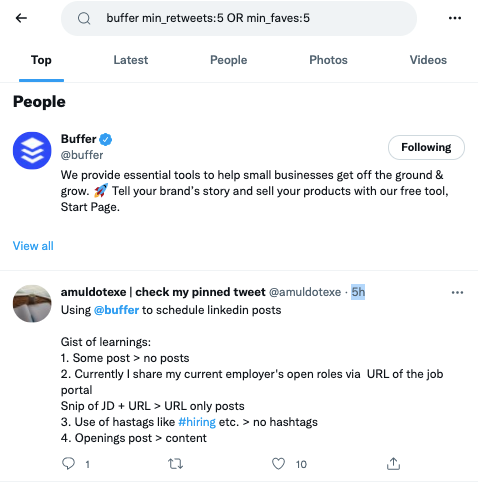
That result will show you tweets that mention Buffer with a minimum of five retweets or five favorites.
4. Find your most popular tweets
Using the same technique, you can also find the most popular tweets from your own Twitter account. To do this, simply head to the Twitter explore page (or use the Twitter Advanced Search function) and search for: “from:[your account] min_retweets 20”.
For example: “from:buffer min_retweets:20”.

It brings back results for tweets sent from the @buffer account with more than 20 retweets.
You could do the same thing for the number of likes a tweet has received. By typing in the phrase, “Buffer scheduling min_faves:10" the Twitter will show tweets that have received at least 10 likes.
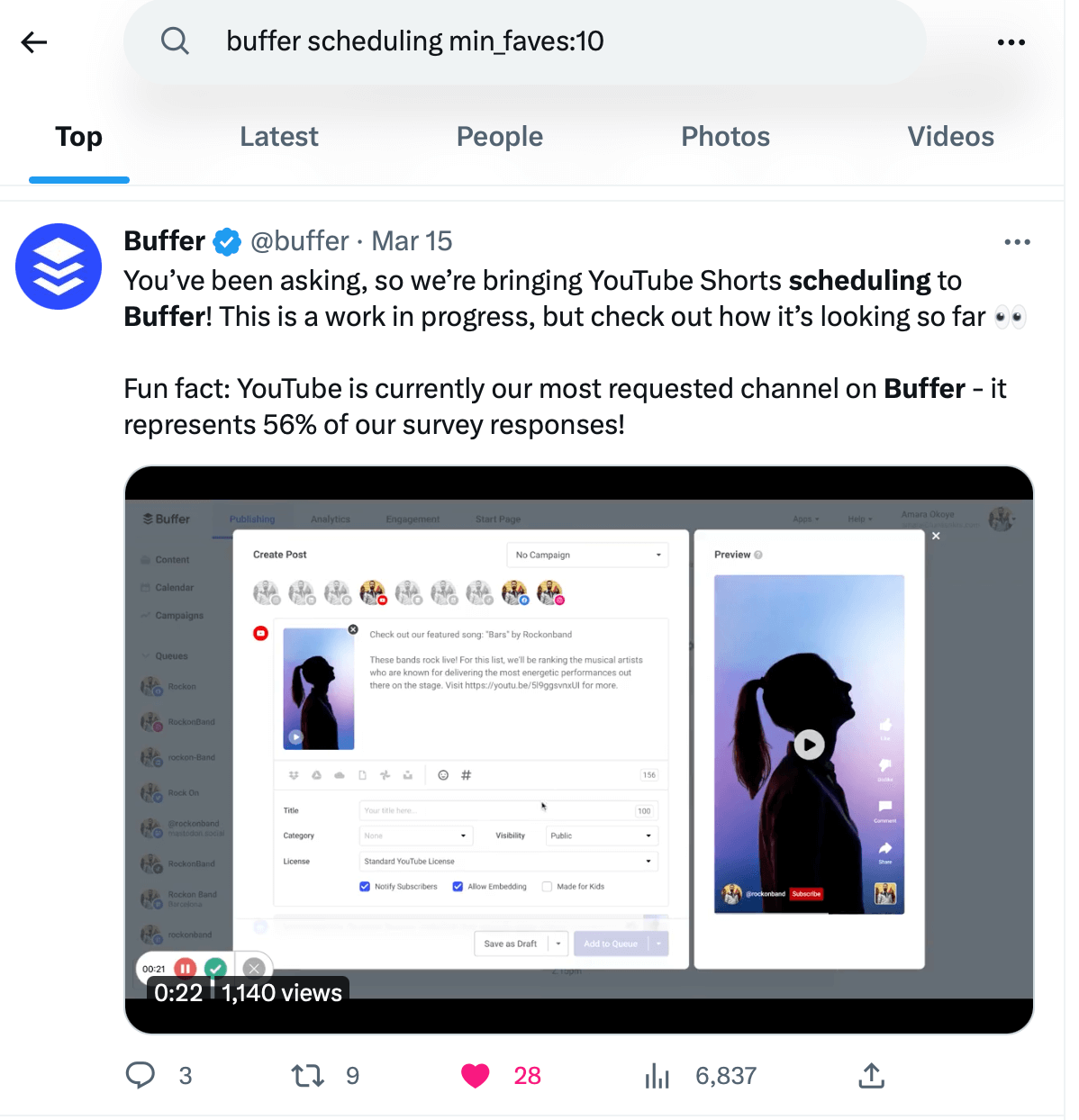
5. Find ideas for blog posts
Twitter is a great source of inspiration for blog posts. When using Advanced Search for research, you can look at what people are saying about a particular subject.
Here’s a search we did in Twitter Advanced Search to research this very post.
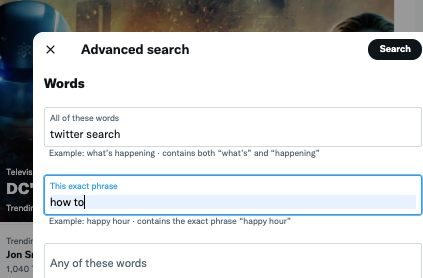
6. Find content shared by selected accounts
If you would like to see what your favorite tweeters are saying about a certain topic, search for a keyword and their names.
For example, this search: “LinkedIn (from:TechCrunch)” displays all the tweets about LinkedIn from TechCrunch.

7. Embed tweets in your website or blog post
Embedding real-time tweets within your website or blog post can be a great way to make your content more interactive.
To embed tweets in your blog or website, visit https://publish.twitter.com/ and enter the URL of the timeline you’d like to embed. For example, you can choose the URL of a tweet or a Twitter profile or include a Twitter handle or hashtag.

After you’ve made your selection, simply copy and paste the code into the HTML of your website or blog.
For example, here’s the code we got for tweets from Buffer’s Twitter handle:
<a class="twitter-timeline" href="https://twitter.com/buffer?ref_src=twsrc%5Etfw">Tweets by buffer</a> <script async src="https://platform.twitter.com/widgets.js" charset="utf-8"></script>
8. Filter tweets by location
If you want to find people who are talking about your brand in a specific location, use the two operators near: and within:
The near operator is followed by the location's name, which can be a city, state, country, postal code, or geocodes (a location's GPS coordinates, which you can find on Google Maps).
The within operator is followed by the distance. By default, Twitter uses 15 miles, but you can change the distance by adding in miles.
For example, if you want to search for tweets about pizza in Boston with a 10-mile limit, here's what the search term would be: “Pizza near:Boston within:10mi”.

9: Connect with influencers
Collaborating with an influencer can help increase your brand exposure. To find influencers on Twitter, you can use the Advanced Search option to find specific brand keywords or hashtags along with the engagement levels you want to see, such as the minimum number of retweets, replies, or likes. You can also narrow down your search in the results page to a specific area by using the Twitter search operator for location.
For example, let’s say you’re a makeup brand looking for a beauty blogger or makeup artist to collaborate with in Chicago. Your search would look like this: “#Makeup near:Chicago within:10mi min_faves:5 min_retweets:20”.
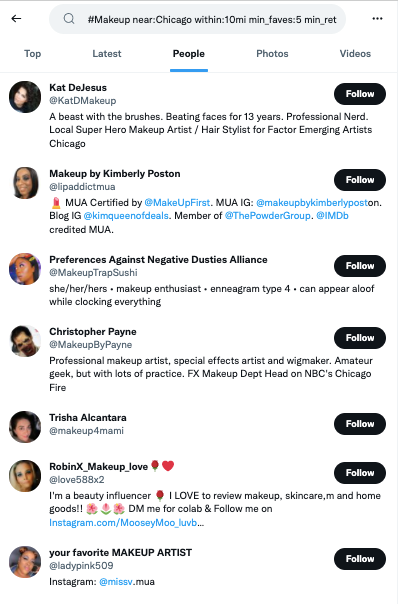
In your search results, you’d find the profiles of beauty bloggers and makeup artists near Chicago who meet your specified engagement criteria.
10. Get media coverage for your brand
Generate some PR buzz for your brand by using Twitter to find journalists actively looking for a scoop. Journalists and PR companies often use hashtags like “#journorequest” and “PRrequest” to find people and businesses to interview or feature in their stories.
For example, #Journorequest “small business” would be a useful search for a small business owner looking for PR coverage.

The results reveal tweets from journalists who want to connect with small business owners for a story they are working on.
11. Monitor mentions of your company
Using Twitter’s Advanced Search to monitor your brand can be extremely effective. As well as monitoring mentions of your brand name, Advanced Search also allows you to keep an eye on mentions of your Twitter handle and even any tweets that include your URL.
Here’s a search for all things Buffer:

12. Filter out competitor tweets
If you want to filter out any results mentioning competitors of yours, you can do so by adding their username and URL in the “None of these words” Advanced Search field.

13. Discover customer sentiment about your business
Twitter search is a great way to quickly get a snapshot of how your customers feel about your business.
These types of searches will help you stumble upon some great feedback and ideas, too. For example, a tweet in which a customer expresses frustration could spark discussion about improving your product or service.
To include sentiment filters in your search, add a happy or unhappy emoticon to the end of your search term, e.g., “@AppleSupport :( ” or “@AppleSupport :)”.
14. Level up your customer service
Responding quickly to your customers is an important part of customer service. You can find queries or complaints about your brand on Twitter by searching for terms like "customer service" or "support," along with your brand keywords. This is particularly useful for finding tweets that don't directly @ mention your brand.
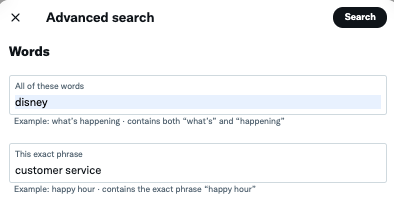
15. Search your competitor’s tweets
This is a great tip we picked up from Tim Baran. Using Advanced Search, you can filter through tweets from any account and for selected keywords. To do this, simply use the “All of these words” and “From these accounts” fields.
When we searched for the word “transparency” from the @buffer Twitter account, we found all the tweets from our Twitter account that mention “transparency.”

As a shortcut, you could search transparency (from:buffer) in the search bar.
16. Monitor sentiment about competitors
Twitter Advanced Search gives you the same information you get when you monitor sentiment about your own brand. It empowers you to keep tabs on how customers are talking about your competitors, too.
For example, to find out how your competitor’s customers feel about a specific topic, you could combine the search queries: “@brand :( ”.

This will return tweets that mention the brand along with the unhappy emoticon.
17. See results only for the people you follow
Twitter moves fast, and sometimes it can be easy to miss great content from the people you follow.
Thankfully, Twitter search allows you to filter tweets only from the people you follow. This is a great way to make sure you don’t miss anything from your favorite tweeters on the subjects you care about.
For example, if you wanted to find out who among your followers are talking about content marketing, you would type “content marketing” in the search bar, hit enter, and then refine your search by selecting “People you follow” in the Search filters.

18. Find videos related to a topic
If you want to find a video on a specific topic, Twitter Search provides a great alternative to YouTube Search. To filter your video searches, use either Advanced Search or the search bar on the Twitter home page and then select Videos from the results page filters.
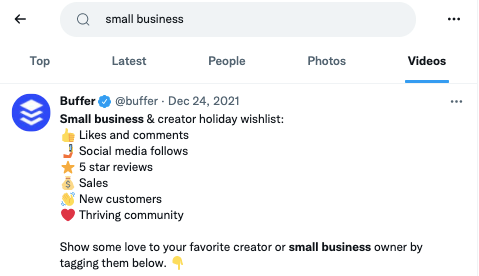
What you see is a list of all tweets that have videos in them.
19. Find photos related to a subject
You can also search Twitter for images using either the Advanced Search function or the Twitter home search bar and then select Photos from the results page filters.

20. Search for things you think people will say
Listening is extremely important in social media, and by keeping an eye on what people are saying, you can find some potential customers within your target audience.
Twitter Search is a little different than Google Search. When you’re thinking of keywords and phrases to query, think about how people talk to each other. Tweets tend to be a lot more conversational than Google search terms.
You can search for terms like:
- “How do I …?”
- “ anyone recommend …?” + a keyword
- “any advice on” + a keyword
For example, suppose you run a plant-based nutrition business. You could search "can anyone recommend" protein powder.

Once you find people who could be your future customers, connect with them, start a conversation, and build relationships before you start selling.
Supercharge your Twitter account
Twitter Advanced Search is a powerful tool for finding new leads, building relationships, and promoting your business.
Another tool we recommend is Buffer's analytics features to measure your social media performance and get insights and recommendations on how to grow reach, engagement, and sales for your business.
Used in conjunction with Twitter Advanced Search, Buffer Analyze can help take your Twitter account to the next level.
Try Buffer for free
190,000+ creators, small businesses, and marketers use Buffer to grow their audiences every month.



